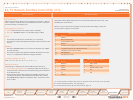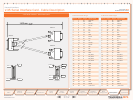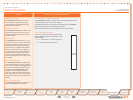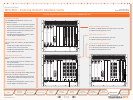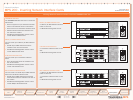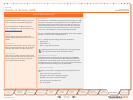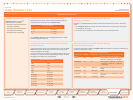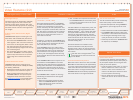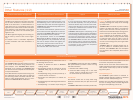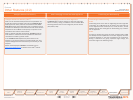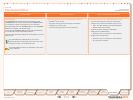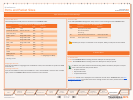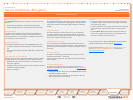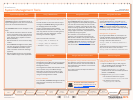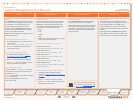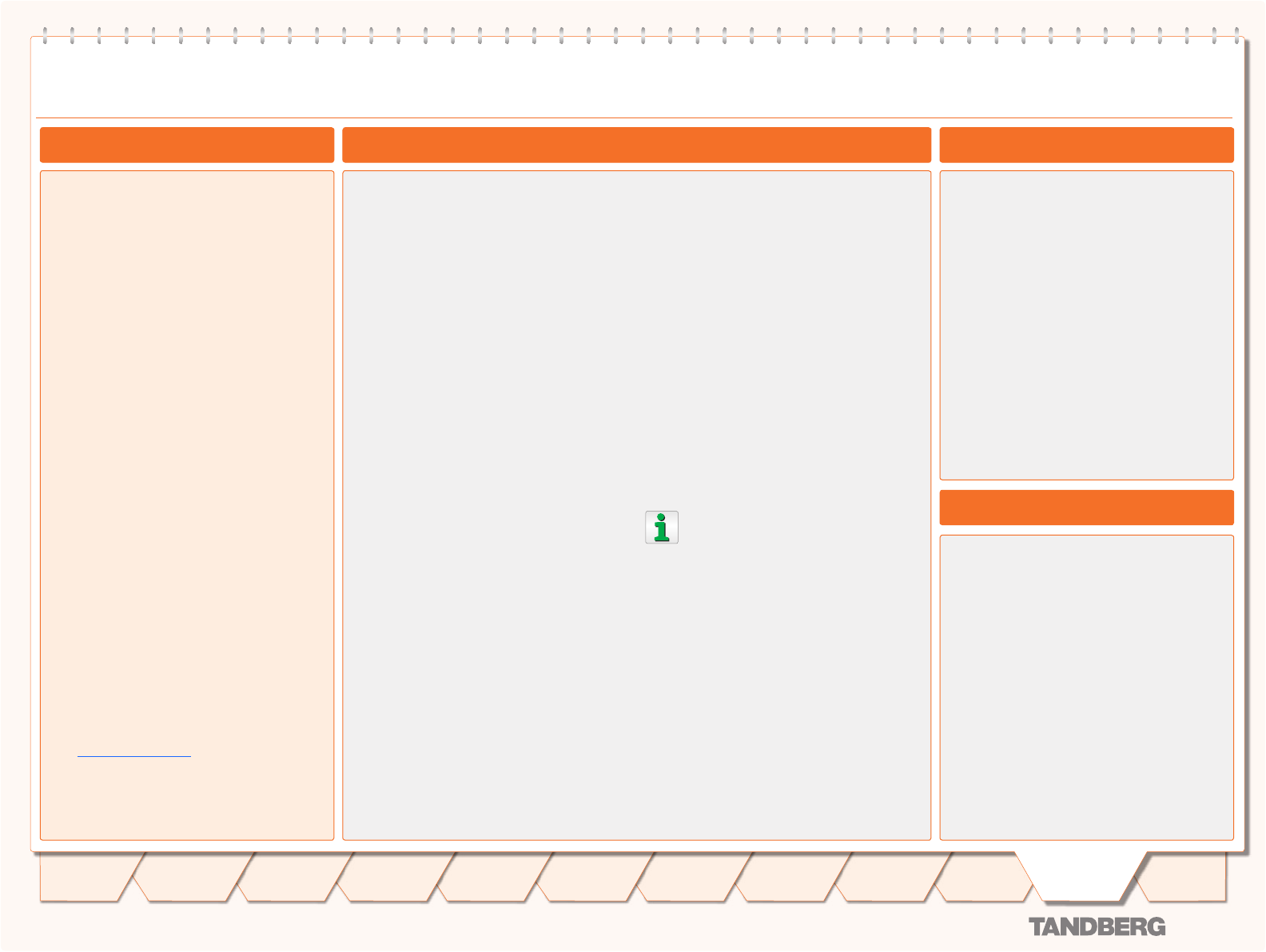
D 13373.08
NOVEMBER 2007
MPS
Table of
Contents
TANDBERG MPS
ADMINISTRATOR GUIDE
Dual Video Stream
- DuoVideo
TF
/ H.239 / BFCP
Dual Video Stream (DuoVideo
TF
/H.239/BFCP)
is a feature that allows two simultaneous video
streams to be transmitted from one system
and be received by the other participants. This
feature is supported on both H.320, H.323 and
SIP. This allows a presenter and their presenta-
tion to be seen at the same time, in much the
same way you would expect them to be in a
local room environment.
If systems in a conference are TANDBERG dual
monitor systems, they will receive the presenter
on one screen and the presentation (PC, Doc-
Cam, VCR, DVD etc) on the other.
If the TANDBERG system is a single monitor
system with default settings, the video stream
will automatically switch from the presenter to
the presentation. This change will take place
on the fly, with the displayed stream returning
to the presenter when the Dual Video Stream is
disconnected.
In the TANDBERG MPS there is support for mix
of DuoVideo
TF
and H.239/BFCP in the same
conference. Other manufacturer’s systems sup-
porting neither DuoVideo
TF
nor H.239/BFCP can
be in the same conference when the second
video stream is sent, but they will not be able to
receive the second stream.
The TANDBERG MPS is capable of receiving/
transmitting two simultaneous video signals
from/to all sites.
When one of the sites requests for Dual 1.
Video the TANDBERG MPS will open Dual
Video towards all the other video sites
capable of receiving it.
Now, if another site requests for Dual Video 2.
the TANDBERG MPS will automatically trans-
mit this new site’s Dual Video to the rest of
the sites if possible.
If H.239 or BFCP is not supported by a site, the
TANDBERG MPS uses High Speed Data rates
(HSD) for DuoVideo
TF
. If any of these sites does
not support HSD, DuoVideo
TF
will still be trans-
mitted to the sites supporting this. The sites
not supporting HSD will in that case receive the
same video stream as the others see on their
main video (and therefore not use all of their
available meeting rate).
Dual Video Streams are available in both
Continuous Presence mode (CP) and Voice
Switched mode or when one site has the floor,
regardless of which site is broadcasted on the
main stream.
Note that when running DuoVideo
TF
the
video algorithm for the main stream will
not be H.264.
Automatic Bandwidth Adjustment
When Dual Video is sent to the sites, the TAND-
BERG MPS will automatically use approximately
1/2 of the original video bandwidth for the main
video stream and the other half for Dual Video.
When Dual Video is no longer transmitted, the
TANDBERG MPS will automatically upspeed the
main video stream to its original bandwidth.
4CIF Digital Clarity
TF
This feature allows for H.263 4CIF (704x576)
live video images to be sent to the far end,
allowing 4 times higher resolution than tradi-
tional videoconferencing systems for displaying
document camera video and other high-resolu-
tion images.
H.263+ Custom Video Formats (Digital
Clarity
TF)
TANDBERG MPS supports encoding of a true
XGA, SVGA, VGA and NTSC (SIF) resolutions.
This allows the TANDBERG MPS to send all •
video signals in their true native resolution.
If the source is sending XGA, SVGA or VGA, •
the receiving system will decode and dis-
play the same quality image as was sent by
the transmitting side.
Also supported under the H.263+ custom •
formats is TANDBERG’s use of SIF (Source
Input Format) that allows for an improved
NTSC image over traditional CIF based
MCU.
H.263+ Widescreen formats
TANDBERG MPS support encoding of true
widescreen (16:9) formats: w288p (512x288)
and w576p (1024x576).
Widescreen formats will only be used if all •
participants in the conference support it.
When encoding widescreen formats, the •
TANDBERG MPS will use special layouts
designed to utilize widescreen monitors.
See Conference Layouts in the Create Confer-
ence view for a list of all available layouts.
Video Features (2:2)
DuoVideo
TF
, H.239, BFCP
The ITU standard H.264
The ITU standard H.264 provides considerably
better video quality at lower bandwidths.
It has been developed with strong TANDBERG
participation in joint workgroups of ITU-T and
ISO.
H.264 is based on the ISO standard MPEG-4. •
The TANDBERG MPS supports H.264 video •
compression in both CIF and SIF resolutions.
An encoding and decoding rate of a high-•
quality 30 frames per second is achieved.
H.264 may be used on the TANDBERG MPS •
for endpoint up to 768kbps.
Optimal Voice Switch
In Optimal Voice Switched mode the MPS will
automatically send the optimal video quality to
all participants capable of receiving the video
quality of the active speaker.
To get the optimal quality video, no icons or •
text are added to the video in this mode.
If there is a site on the conference con-•
nected on H.320 special means are taken
to ensure optimal interworking.
Sites on H.320 will receive transcoded •
video while sites on IP will receive switched
video.
4CIF Digital Clarity
TF
, H.263, H.263+ H.264
Optimal Voice Switch
Features
158
Introduction
Quick
Setup
Using
the MPS
System
Status
System
Configuration
Installation
Gateway
Configuration
MCU
Configuration
Appendices
Main
Technical
Descriptions



